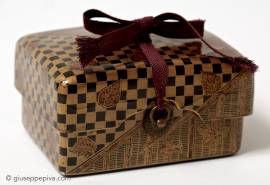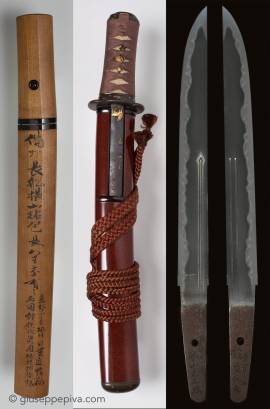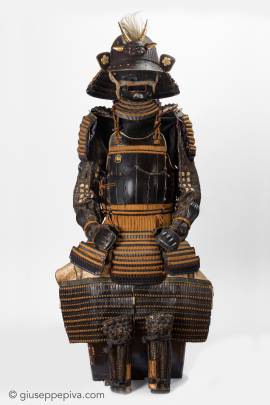Antique sweet-box with katami-gawari decorationEarly Edo period (1603-1868) 17th century 8 x 11 x 5.5 cmThis antique lacquer kashibako is made with a paper core instead of the usual wooden one, resulting in being extremely light.A bolt-shaped line (katami-gawari) across the top divides the surface into two parts, each decorated with a different texture; this particular feature is typical of the Momoyama and early Edo period lacquerware. On one side, the design represents chrysanthemum’s leaves on a bamboo curtain background, while on the other there are hollyhock leaves...
WORKS FOR SALE
Tanto in koshiraeShinshinto, 19th centuryNagasa [length]: 24.8 cmMotohaba: 2.9 cm,Kitae [forging pattern]: ko-itameHamon [tempering pattern]: midare and choji midareBōshi [point]: ko-maruku; kaeruHorimono: suken on omote and goma-ashi on uraNakago [tang]: ubu, sujikai; one mekugi-ana.Inscribed on both sides and on the back:Attributed by Kanzan sensei to Bizen Osafune Yokoyama SukekaneGifted on 31/01/1972 for the birthday to Toshio from his grandfather AkioEngraved by Living National Treasure Gassan SadakazuKoshirae: the tantō comes with a good Higo koshirae. The...
Samurai armor with a stylised torso designEarly to mid Edo period, 18th century The unique construction of this authentic samurai armor is made to resemble the nude torso of a Buddhist guardian deity, Niō. In fact, the front section is composed by six shaped plates, not including the top one, that outline the design of breast muscles. This kind of design, in a very naturalistic render rather than stylized as in this case, was popular among samurai since the Momoyama period and some famous suits of armor are embossed as a nude torso.The helmet is a Haruta school 50 plates sujibachi...
Copyright © 2016 - giuseppe piva - VAT: 05104180962










